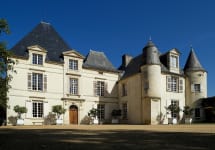Chateau Haut-Brion (bin soiled label) 1995
-
Robert
Parker -
Wine
Spectator
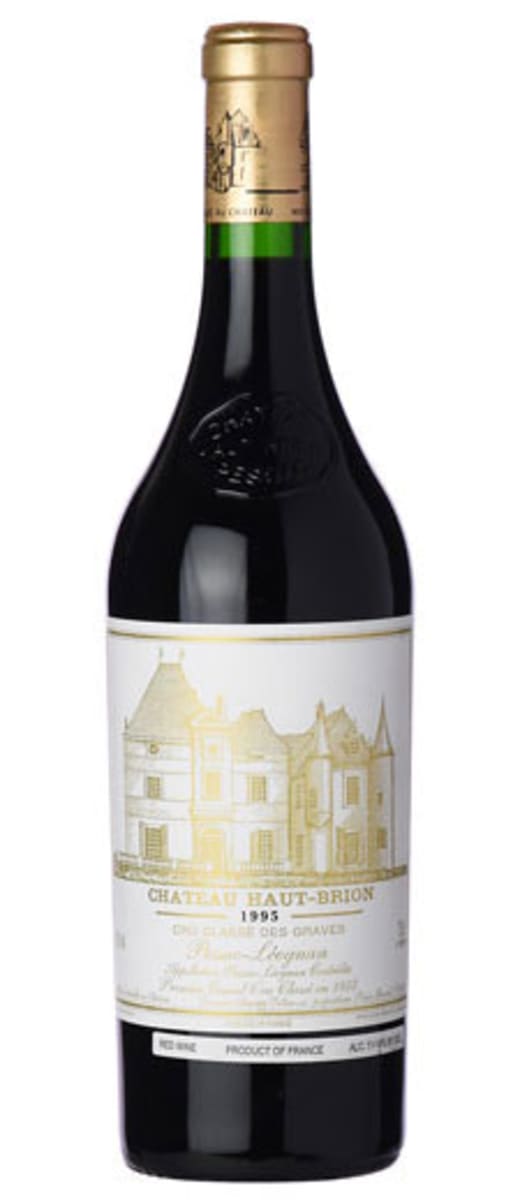


Product Details
Your Rating
Somm Note
Winemaker Notes
The characteristic of this wine is its harmony between the very soft and very fine structure and the complex aroma given by the earth of the “Graves”. There is a lot of charm in this bottle which could be consumed either in the next few years or be kept in the cellar as the wine will age remarkably.
Professional Ratings
-
Robert Parker's Wine Advocate
It is fun to go back and forth between the 1995 and 1996, two superb vintages for Haut-Brion. The 1995 seems to have sweeter tannin and a bit more fat and seamlessness when compared to the more structured and muscular 1996. Certainly 1995 was a vintage that the brilliant administrator Jean Delmas handled flawlessly. The result is a deep ruby/purple-colored wine with a tight but promising nose of burning wood embers intermixed with vanilla, spice box, earth, mineral, sweet cherry, black currant, plum-like fruit, medium to full body, a high level of ripe but sweet tannin, and a finish that goes on for a good 40-45 seconds. This wine is just beginning to emerge from a very closed state where it was unyielding and backward. Anticipated maturity: 2006-2035.
-
Wine Spectator
Haut-Brion always does it right. This enticing white Bordeaux shows full body, medium acidity and is simply brimming with gorgeous aromas and flavors of coconut, lemon and papaya. A long vanilla and apple pie aftertaste completes the package.
Other Vintages
2024-
James
Suckling - Vinous
-
Robert
Parker
-
James
Suckling - Decanter
- Vinous
-
Jeb
Dunnuck -
Robert
Parker
-
James
Suckling -
Jeb
Dunnuck -
Robert
Parker - Decanter
-
Wine
Enthusiast -
Robert
Parker -
James
Suckling - Decanter
- Vinous
-
Jeb
Dunnuck -
Wine
Spectator
-
Jeb
Dunnuck -
Robert
Parker -
James
Suckling -
Wine
Enthusiast - Decanter
-
James
Suckling -
Robert
Parker -
Jeb
Dunnuck - Decanter
-
Wine
Spectator
-
Robert
Parker -
James
Suckling - Decanter
-
Wine
Enthusiast -
Jeb
Dunnuck -
Wine
Spectator
-
James
Suckling - Decanter
-
Robert
Parker -
Wine
Spectator -
Wine
Enthusiast -
Jeb
Dunnuck
-
Robert
Parker -
Wine
Enthusiast -
James
Suckling - Decanter
-
Jeb
Dunnuck -
Wine
Spectator
-
Robert
Parker -
Jeb
Dunnuck -
James
Suckling -
Wine
Spectator - Decanter
-
Wine
Enthusiast
-
Wine
Enthusiast -
James
Suckling -
Jeb
Dunnuck -
Robert
Parker -
Wine
Spectator - Decanter
-
Robert
Parker -
James
Suckling -
Wine
Enthusiast -
Wilfred
Wong -
Wine
Spectator
-
James
Suckling -
Wine
Spectator -
Wine
Enthusiast -
Robert
Parker
-
Jeb
Dunnuck -
Robert
Parker -
Wine
Spectator -
Wine
Enthusiast -
James
Suckling
-
Robert
Parker -
James
Suckling - Decanter
-
Wine
Spectator -
Wine
Enthusiast
-
Wine
Enthusiast -
Robert
Parker -
James
Suckling -
Wine
Spectator
-
Wine
Enthusiast -
Robert
Parker -
Wine
Spectator
-
Robert
Parker -
Wine
Enthusiast -
Jeb
Dunnuck -
Wine
Spectator -
Wine &
Spirits
-
Robert
Parker -
Wine
Spectator -
James
Suckling -
Jeb
Dunnuck - Decanter
-
Wine
Enthusiast -
Wine &
Spirits
-
Wine &
Spirits -
Wine
Enthusiast -
Wine
Spectator -
Robert
Parker
-
Wine
Enthusiast -
Wine
Spectator -
Robert
Parker
-
Jeb
Dunnuck -
Wine
Spectator
-
Wine
Spectator -
Wine &
Spirits -
Robert
Parker
- Decanter
-
Robert
Parker -
Jeb
Dunnuck -
Wine
Enthusiast -
James
Suckling -
Wine &
Spirits -
Wine
Spectator
-
Robert
Parker -
Wine
Spectator -
James
Suckling
-
Wine
Spectator -
Robert
Parker
-
Wine
Spectator
-
Robert
Parker -
Wine
Spectator
-
Wine
Spectator -
Robert
Parker
-
Robert
Parker -
Wine
Spectator
-
Robert
Parker -
Wine
Spectator
-
Robert
Parker -
Wine
Spectator
-
Wine
Spectator -
Robert
Parker
-
Robert
Parker
-
Robert
Parker - Decanter
-
Wine
Spectator
-
Wine
Spectator
-
Wine
Spectator -
Robert
Parker
-
Robert
Parker
-
Robert
Parker
-
Wine
Spectator
-
Robert
Parker -
Jeb
Dunnuck

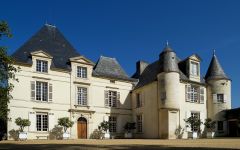
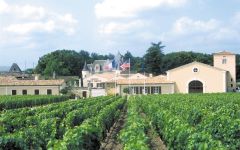
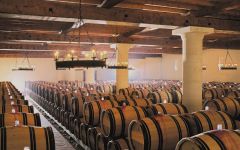
Chateau Haut-Brion is the oldest and by far the smallest of the "Premiers Grands Crus" vineyards of the Gironde 1855 classification. Chateau Haut-Brion is one of the few remaining family-owned domains of the Bordeaux region with a history going back to the 16th century. It has been owned by the American Dillon family since 1935.Thanks to its long history as one of Bordeaux's most prestigious wines, the estate has left its mark on the region for centuries.
The vineyard covers an area of 51 hectares (about 126 acres). Slightly more than 48 hectares are planted with red grape varieties. The terrain at Haut-Brion, formed of two large mounds of a type of gravel known as Gunzian because it was deposited during the earliest geologic stage of the Pleistocene epoch, rises between 40 and 50 feet above the beds of the neighboring streams. This gravel consists of small stones, including various kinds of quartz, and it is these precious gems that help to give Chateau Haut-Brion's wines their distinctive character. This expansive elevated reach of gravelly terrain, bounded at the north by the Le Peugue stream and at the south by the Le Serpent stream, has been called Haut -Brion at least as far back as the early years of the fifteenth century, as evidenced by ancient maps and deeds dating from this period. The sub-soil consists of a mixture of clay and sand.

One of the world’s most classic and popular styles of red wine, Bordeaux-inspired blends have spread from their homeland in France to nearly every corner of the New World. Typically based on either Cabernet Sauvignon or Merlot and supported by Cabernet Franc, Malbec and Petit Verdot, the best of these are densely hued, fragrant, full of fruit and boast a structure that begs for cellar time. Somm Secret—Blends from Bordeaux are generally earthier compared to those from the New World, which tend to be fruit-dominant.

Recognized for its superior reds as well as whites, Pessac-Léognan on the Left Bank claims classified growths for both—making it quite unique in comparison to its neighboring Médoc properties.
Pessac’s Chateau Haut-Brion, the only first growth located outside of the Médoc, is said to have been the first to conceptualize fine red wine in Bordeaux back in the late 1600s. The estate, along with its high-esteemed neighbors, La Mission Haut-Brion, Les Carmes Haut-Brion, Pique-Caillou and Chateau Pape-Clément are today all but enveloped by the city of Bordeaux. The rest of the vineyards of Pessac-Léognan are in clearings of heavily forested area or abutting dense suburbs.
Arid sand and gravel on top of clay and limestone make the area unique and conducive to growing Sémillon and Sauvignon blanc as well as the grapes in the usual Left Bank red recipe: Cabernet Sauvignon, Merlot, Cabernet Franc and miniscule percentages of Petit Verdot and Malbec.
The best reds will show great force and finesse with inky blue and black fruit, mushroom, forest, tobacco, iodine and a smooth and intriguing texture.
Its best whites show complexity, longevity and no lack of exotic twists on citrus, tropical and stone fruit with pronounced floral and spice characteristics.
